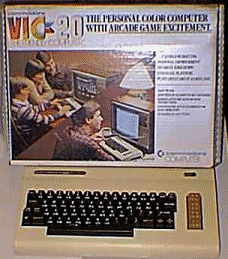 The importance of the Commodore VIC-20 to computer history can hardly be understated. More computer
companies all over the world were laid waste and cast aside by this humble little machine than
any other computer can claim.
The importance of the Commodore VIC-20 to computer history can hardly be understated. More computer
companies all over the world were laid waste and cast aside by this humble little machine than
any other computer can claim.It all started in the year 1980. During a European conference, Commodore president Jack Tramiel received reports of impending Japanese movement in the computer market. This cast a great shadow of fear over Tramiel's heart. The Japanese had a nasty habit of waiting until a piece of merchandise reached a commodity status in the mass market. They would then pool their collective resources to produce the merchandise at dirt-low costs, and dump their cheaply produced goods in foreign markets. This would catch the current market leaders, who were often the creative entrepreneurs in the industry, by surprise. Unable to compete at the price levels dictated by their Japanese competitors, these market leaders were usually doomed. Tramiel knew of this fact intimately. It had happened to Commodore's Typewriter and Adding Machine business before. He feared it would happen to his computer business now.
It was during this conference that Tramiel delivered his announcement. Commodore would produce a color computer for less than $300.00 in 9 months or else! Moreover, he announced that this would be a wholly Japanese computer. "The Japanese are coming, so we must become the Japanese!" rang in conference attendees ears. The next day, at Commodore Japan, development began in earnest.
The new computer would be based off of MOS technologies venerable 6502 processor and their brand new Video Interface Chip, known as "VIC" for short. Originally intended for video game machines, the new chip featured both graphics and sound, and displayed text on 22 columns of 23 lines in 8 colors. The secret to keeping the cost of the new computer low, however, lay in memory. Only 5k was designed into the computer, though it would be expandable to 32k.
Back at Commodore headquarters, the opinion was very mixed. The old-line computer folks, lead by genius engineer Chuck Peddle, were plainly against the new machine. Some of them scolded Tramiel, and pushed for a new $5000.00 Color PET. They hoped for Commodore to compete with Apple in the high end computer market, selling to companies and educational institutions. Others merely laughed at the specs of the new machine, hoping to drown the project in their scorn.
In 1981, despite all the skepticism, the VIC was officially born. First released in Japan by their creators, the VIC-1001 met with limited, but warm success. In Germany, the VIC was called the VC-20 and referred to as "VolksComputer". In the U.S., the VIC-20 was nicknamed "The Friendly Computer" by marketers. It was the low price and competitive features, however, that won over customers. To the horror of their competition, Commodore released the VIC at a paltry $300.00. Within two years, the price was down to $130. VICs flew off of store shelves, and at one point reached a run rate of 9000 units per day. No one at Commodore was laughing any more.
Jack Tramiel had accomplished his goal, and the U.S. market was his. The Japanese didn't even bother releasing their computers in the U.S., deciding to withdraw instead and study their defeat. Companies like Atari, Texas Instruments, Timex/Sinclair, Radio Shack, and others were quickly driven into the ground. Only Apple and IBM survived this time unscathed, choosing to remain in the high-end computer market and concede the home market to the new dominant player: Commodore Business Machines.
Source: The Home Computer Wars by Michael Tomczyk.
Click here to return to the main pictures page
If you find anything in here you have questions or comments about, feel
free to leave me email right here.
To return to my home page, click here.